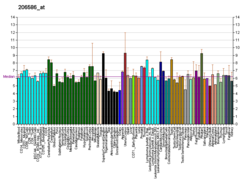Immune system
Primary research on the functioning of the CB2 receptor has focused on the receptor's effects on the immunological activity of leukocytes. [34] To be specific, this receptor has been implicated in a variety of modulatory functions, including immune suppression, induction of apoptosis, and induction of cell migration. [6] Through their inhibition of adenylyl cyclase via their Gi/Goα subunits, CB2 receptor agonists cause a reduction in the intracellular levels of cyclic adenosine monophosphate (cAMP). [35] [36] CB2 also signals via Gαs and increases intracellular cAMP in human leukocytes, leading to induction of interleukins 6 and 10. [15] Although the exact role of the cAMP cascade in the regulation of immune responses is currently under debate, laboratories have previously demonstrated that inhibition of adenylyl cyclase by CB2 receptor agonists results in a reduction in the binding of transcription factor CREB (cAMP response element-binding protein) to DNA. [34] This reduction causes changes in the expression of critical immunoregulatory genes [35] and ultimately suppression of immune function. [36]
Later studies examining the effect of synthetic cannabinoid agonist JWH-015 on CB2 receptors revealed that changes in cAMP levels result in the phosphorylation of leukocyte receptor tyrosine kinase at Tyr-505, leading to an inhibition of T cell receptor signaling. Thus, CB2 agonists may also be useful for treatment of inflammation and pain, and are currently being investigated, in particular for forms of pain that do not respond well to conventional treatments, such as neuropathic pain. [37] Consistent with these findings are studies that demonstrate increased CB2 receptor expression in the spinal cord, dorsal root ganglion, and activated microglia in the rodent neuropathic pain model, as well as on human hepatocellular carcinoma tumor samples. [38]
CB2 receptors have also been implicated in the regulation of homing and retention of marginal zone B cells. A study using knock-out mice found that CB2 receptor is essential for the maintenance of both MZ B cells and their precursor T2-MZP, though not their development. Both B cells and their precursors lacking this receptor were found in reduced numbers, explained by the secondary finding that 2-AG signaling was demonstrated to induce proper B cell migration to the MZ. Without the receptor, there was an undesirable spike in the blood concentration of MZ B lineage cells and a significant reduction in the production of IgM. While the mechanism behind this process is not fully understood, the researchers suggested that this process may be due to the activation-dependent decrease in cAMP concentration, leading to reduced transcription of genes regulated by CREB, indirectly increasing TCR signaling and IL-2 production. [6] Together, these findings demonstrate that the endocannabinoid system may be exploited to enhance immunity to certain pathogens and autoimmune diseases.
Clinical applications
CB2 receptors may have possible therapeutic roles in the treatment of neurodegenerative disorders such as Alzheimer's disease. [39] [40] Specifically, the CB2 agonist JWH-015 was shown to induce macrophages to remove native beta-amyloid protein from frozen human tissues. [41] In patients with Alzheimer's disease, beta-amyloid proteins form aggregates known as senile plaques, which disrupt neural functioning. [42]
Changes in endocannabinoid levels and/or CB2 receptor expressions have been reported in almost all diseases affecting humans, [43] ranging from cardiovascular, gastrointestinal, liver, kidney, neurodegenerative, psychiatric, bone, skin, autoimmune, lung disorders to pain and cancer. The prevalence of this trend suggests that modulating CB2 receptor activity by either selective CB2 receptor agonists or inverse agonists/antagonists depending on the disease and its progression holds unique therapeutic potential for these pathologies [43]
Modulation of cocaine reward
Researchers investigated the effects of CB2 agonists on cocaine self-administration in mice. Systemic administration of JWH-133 reduced the number of self-infusions of cocaine in mice, as well as reducing locomotor activity and the break point (maximum amount of level presses to obtain cocaine). Local injection of JWH-133 into the nucleus accumbens was found to produce the same effects as systemic administration. Systemic administration of JWH-133 also reduced basal and cocaine-induced elevations of extracellular dopamine in the nucleus accumbens. These findings were mimicked by another, structurally different CB2 agonist, GW-405,833, and were reversed by the administration of a CB2 antagonist, AM-630. [44]





